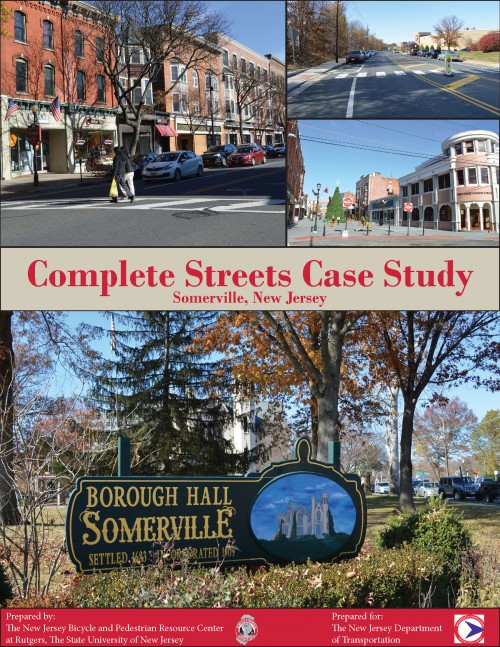In 2009, the New Jersey Department of Transportation adopted a Complete Streets policy which defined a Complete Street as one designed to provide safe access for all users by implementing a comprehensive integrated multi-modal network of transportation options. The benefits include increased safety for all users, connections between origins and destinations, and the promotion of healthier and more livable communities. Since the policy’s adoption, Complete Streets has built momentum throughout the state. As of December 2016, 8 counties and 135 municipalities have followed the lead and adopted their own local Complete Streets policy.
The Bicycle and Pedestrian Resource Center, part of the Alan M. Voorhees Transportation Center at Rutgers University, has developed a series of case studies intended to highlight Complete Streets leaders in New Jersey. The purpose of this case study, funded by the New Jersey Department of Transportation, is to highlight the Borough of Somerville’s Complete Streets policy and implementation history. The report is based on findings provided in interviews with Colin Driver, the Somerville Director of Economic Development; Somerville Councilman Kenneth Utter; Mike Kerwin, President of the Somerset County Business Partnership; Linda Rapacki, Marketing Manager for the Ridewise TMA; and Andras Holzmann, Senior Planner at Somerset County.
For the Borough of Somerville, action came before policy. Although the borough did not pass a Complete Streets policy until September of 2015 (PDF) – being the 119th municipality in New Jersey to do so – they already had a decade of accomplishments to point to. These accomplishments have included a highly successful pedestrianized street, a road diet, and a revitalized downtown that has encouraged living, working, shopping and recreating in a compact walkable environment. Somerville understands that safe walking and bicycling are key to economic development, and Complete Streets are one way for the municipality to grow and prosper in the future.
The report begins with a summary of key findings followed by background information on historical, demographic and land use data collected from Census documents. This information is essential in understanding the context of Complete Streets in Somerville. The report then explores the history of the municipal Complete Streets policy, including how the policy was developed. Successes and challenges are then highlighted for the benefit of other communities looking to implement Complete Streets and a number of next steps provide readers with insight into the policy’s future. This report will serve as a valuable tool for engineers, planners, elected officials, and advocates who want to move forward with Complete Streets in their communities.
Read full report: Complete Streets Case Study: Somerville, New Jersey (2016)

